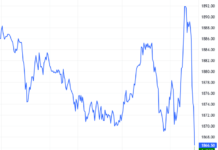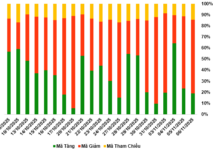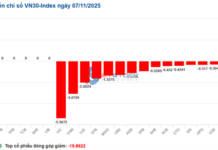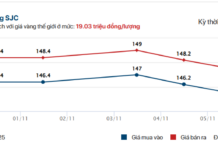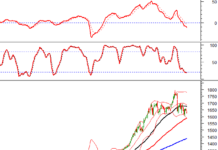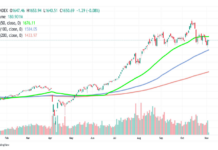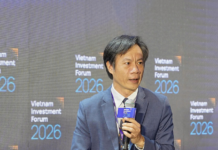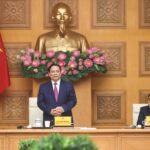
Mr. Le Hong Ha, CEO of Vietnam Airlines – seated in the middle. (Photo: PV/Vietnam+)
|
According to Mr. Le Hong Ha, CEO of Vietnam Airlines, adjusting the upper limit of domestic flight fares will be a condition for airlines to compensate for costs and also an opportunity to adjust their fare ranges in the domestic flight network.
Mr. Le Hong Ha had a discussion with reporters on the sidelines of the International Aviation Conference held in Hanoi on the morning of February 28.
Opportunity to adjust fare ranges
– As of March 1, airfare will be adjusted to increase the upper price limit, what is your evaluation of this? Will this action help increase the airline’s revenue and profit to compensate for the increasing costs?
Mr. Le Hong Ha: Vietnam is one of the few countries in the world that is controlling the upper and lower price levels. However, I believe that in the future, the country will aim for a more open market to increase competition and regulation through the market.
From March 1, the Ministry of Transport has issued Circular No. 34/2023 amending and supplementing some provisions of Circular No. 17/2019 of the Minister of Transport, which sets the price ranges for passenger transport services on domestic flights. Accordingly, the upper price limit on domestic flights will be adjusted to increase by 5% compared to the previous level.
This domestic flight fare increase is also the first adjustment in nearly 10 years (the latest one was in 2015).
Currently, airlines are facing many input costs that have changed, especially fuel prices, exchange rates… The adjustment of the upper limit of domestic flight fares is a condition for airlines to compensate for costs and also an opportunity to adjust their fare ranges in the domestic flight network.
With the fare increase, Vietnam Airlines will continue to have the opportunity to invest in high-paying fare segments while also having the opportunity to attract lower fares to serve the needs of lower-paying passengers or off-peak periods of the market, more promotions will be offered to ensure the balance of interests between airlines and customers, as well as the general policies of the state.
– According to you, will the average airfare in 2024 decrease?
Mr. Le Hong Ha: The average airfare depends on the supply and demand of the market. It is difficult to predict the average airfare in 2024 at this time when the domestic aviation market has changed a lot in recent months.
In the Lunar New Year of the Lunar Year of the Rat 2024, the domestic aviation market decreased by 13% compared to the same Lunar New Year of the year 2023. Thus, this decline reflects the market trends in passenger demand and supply of airlines.
Therefore, airfares in 2024 are estimated to be similar to those in 2023 and not change significantly.
– The domestic tourism industry worries that the higher airline fares during the Summer season will make it difficult to attract more travelers, especially in areas that have launched or stimulated many programs. So what will Vietnam Airlines share about airfares?
Mr. Le Hong Ha: The Vietnamese aviation industry has 2 peak seasons: the Lunar New Year peak season and the Summer peak season to compensate for the off-peak periods to bring about the overall efficiency of the aviation industry. In peak seasons, airlines often have the opportunity to sell their optimal fares. For the summer of 2024, Vietnam Airlines and other airlines will apply optial fares based on the price limit set by the state, the Ministry of Transport.
– Recently, some airlines have cut many domestic routes. So, is this an opportunity for Vietnam Airlines to exploit its potential and advantages on these routes, sir?
 Passengers go through aviation procedures at Noi Bai International Airport. (Photo: PV/Vietnam+)
|
Mr. Le Hong Ha: Each airline has its own business model and fleet development strategy to serve its segments and market.
For low-cost airlines, they often choose a specific type of aircraft to simplify the operation processes, operations, and technical maintenance in order to achieve the lowest costs and provide low fares in the market. As for traditional airlines, which operate multiple passenger segments and fly condensed continents like Vietnam Airlines, they must use suitable types of aircraft according to their strategies. Any airline that finds their business model unsuitable will make changes.
Change in aircraft management
– How do you evaluate the recovery of Vietnam’s international aviation market seeing that the international aviation market is growing?
Mr. Le Hong Ha: There are indeed positive signs, the aviation transport market is recovering faster than the forecast of the International Air Transport Association (IATA). With Vietnam, the international market to the country has returned after the Government focused on tourism policies, liberalizing entry and exit, and attracting returning customers. Regions such as Europe, Australia, Northeast Asia, and Southeast Asia have had very good comebacks.
However, the Chinese and Japanese markets are still weak and low. Visitors to Vietnam cannot return to the pre-pandemic period (2019) and there are still many things to do to attract this important market to our country.
The return of international tourists after COVID-19 is not only in Vietnam, but other countries also have initiatives to launch their markets. To attract more guests, we need to ensure unified tourism product policies that must be attractive, competing with the tourist destinations of countries in the region. This is very important in order to bring sustainable guests and frequent returns in the near future.
– With the dispatch of the Airbus A320 Neo engines for inspection and maintenance according to the manufacturer’s recommendation, there is an aircraft shortage and the supply capacity is affected. So, what solutions does Vietnam Airlines have to ensure stable operations?
Mr. Le Hong Ha: Airlines are currently facing the biggest challenge, which is the supply chain disruption, spare parts shortage that has been occurring in the past 2-3 years, especially during the COVID-19 pandemic. Scarcity of resources such as technicians and maintenance facilities has led to changes in airlines’ aircraft management.

Field of maintenance and repair of aircraft always applies the latest technology. (Photo: CTV/Vietnam+)
|
In the short term, Vietnam Airlines has solutions to ensure stable and efficient aircraft operations, to increase operational productivity to compensate for the resource shortages of the aircraft fleet that must be sent for maintenance.
For example, the Airbus A320 Neo engines have been affected (over 3,500 engines were affected worldwide and must be checked. Vietnam Airlines alone has 24 engines of 12 aircraft that must be sent for inspection and affecting flight operations.
Previously, on average, an engine maintenance took 100-120 days, but now it takes up to 250-300 days. Therefore, airlines must manage how to deal with spare parts and components shortages to continue to maintain supply capacity to serve the market and passengers, meaning that the maintenance and operations activities must increase productivity.
In the long term, with the aviation industry and Vietnam Airlines, how to manage and shorten the maintenance process, increase resources, and incorporate new technologies is a common story of the aviation industry.
Manufacturers and engine makers cooperate, share information, use technology, and analyze data to develop optimal repair and maintenance solutions. Airlines must use this data to use in advance or predict the periods when the aircraft must be sent for maintenance in order to ensure long-term aircraft operations.
– Thank you, sir. /.
Viet Hung


